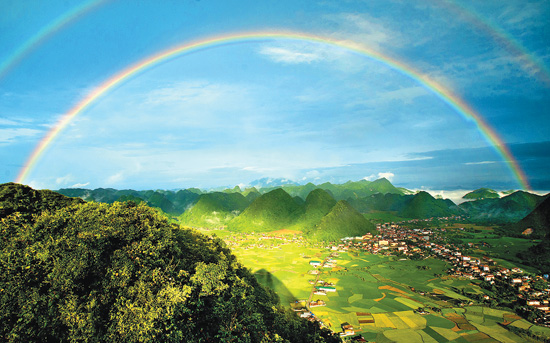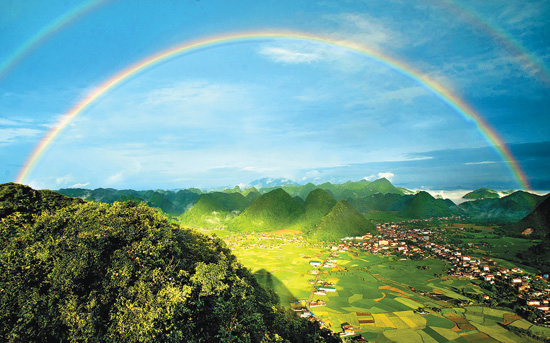
Bac Son is a 6,979km2 mountainous district of Lang SonProvince, where archeologists have found traces of Neolithic settlements of theancient Viet people.
The province records show that Bac Son has 13 nationalvestige sites, and 12 provincial sites, such as Mo Tat Village, the outpost ofMo Nhal, Pac Mo Village, Nong Luc Temple, etc.
A brochure produced by the Lang Son government alsodescribed Bac Son as a mostly mountainous area with majestic views andbeautiful landscapes at Tam Hoa Lake, Vu Lang Lake, Pac Mo Lake, etc.
Among the many attractions of the district, to somephotographers and tourist Bac Son valley is a must-see “at least once in alifetime.â€

The valley is quite wide, surrounded by row after row ofcloud-covered mountains. The township of Bac Son occupies just a little patchof this level valley. Paddy fields take up the rest of it.
Tay people’s habitats, rice fields and hundreds of stiltedhouses, have a contributed to the dreamy grandeur of Mother Nature’s creation,making a poetic picture of subtle idyll.
The colors and the overall feel of Bac Son change all thetime. After rice- planting season, the valley is filled with the sweet dampgreen of young rice leaves. Before the harvest, it’s a golden carpet shining inthe sun.
Photographer Nguyen Phung Chi, who has been to Bac SonValley over ten times, remarked, “Even within a day, the valley changes itsbeautiful dresses so many times, due to the constant change in density andmovement of mist and clouds. These two elements and the sun in its dailyjourney from dawn to dusk create countless subtle nuances in the colors andshades over the valley.â€



The mesmerizing height
“One way to capture the beauty of Bac Son Valley in itsentirety is to climb up the nearby peaks, and Na Lay Peak is the best. This600m-high spot offers a 360-degree view of the breathtaking, ever-changingwonder. Some photographers bring tents and supplies to Na Lay Peak to stay awhole week to capture the moment,†Chi added.
“First, it takes about 30 minutes to climb the 1,200 precariousmoss-covered stone stairs. Then an hour’s hike will take you to the Na Lay. Theview there will blow away all the fatigue,†photo hunter Duy Lang shared.


He described the view: “At dusk, the river in the middle ofthe fields glows mysteriously, and the land seems to pull the last golden raysof the sun to keep it from sinking. The sky slowly darkens. One after another,lights in the town come up, like fire-flies playing among silent giganticlimestone monuments. Early in the morning, the valley seems to slowly emergefrom under the fluffy blanket of mist and bobbing white clouds. When the firstsun rays appear from behind the rugged curtains, they light up the sky andreveal the soft shawl of clouds around the neck of the mountains. And then, thesplendid red disk rises, promising a glorious day and taking away the hearts ofcontemplating souls.â€
Another photo hunter shared in “Traffic†newspaper, “Theascent is quite steep, and one must be careful not to slip. The hike rims themountain’s skirt, under dangling branches and leaves. Backs sweaty, faces redand short of breath, (yet) none of us was numb in the legs. Here and there, thepath curved out to the open space, exposing us to bright light and a corner ofBac Son appeared like a promise of love, giving us an adrenaline surge thatspeeded up our pace. Having photographed it so many times, I still can’t helpfeeling overwhelmed, standing on Na Lay Peak. Endless green mountains thatshine under the sun embrace the valley. The coquettish blue river gracefullybelts the paddy fields. Some patches harvested, some not yet, all are blurredunder the smoke of burned thatch. It’s such a warm, radiant picture of fertilitythat can soften any heart.â€

